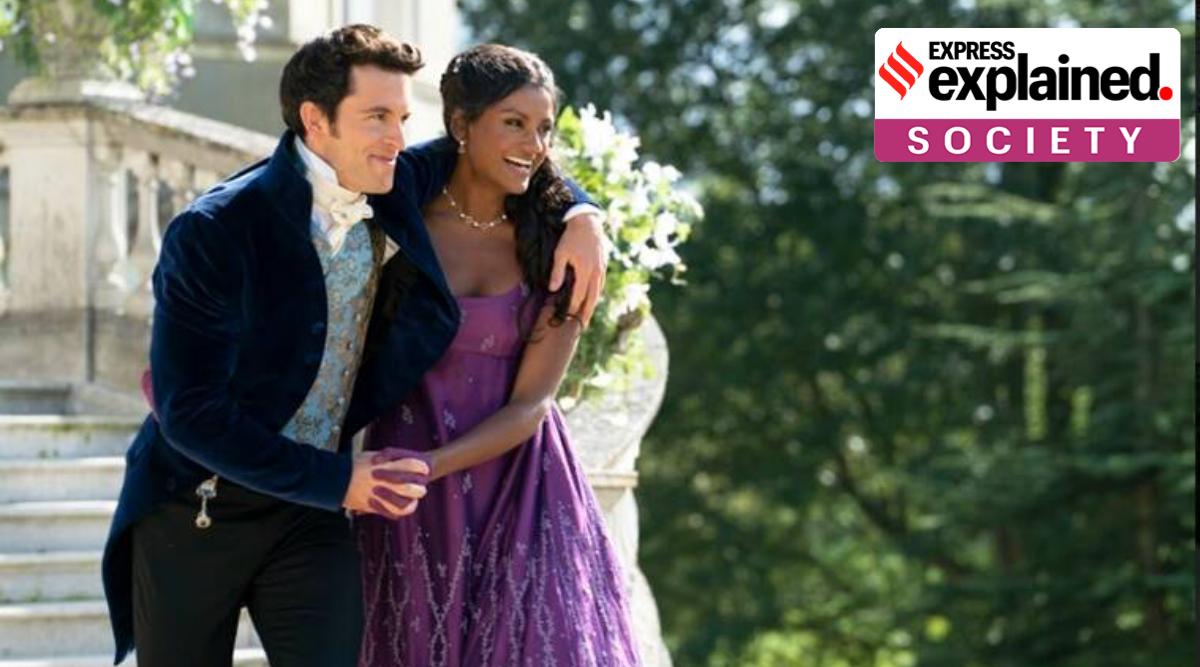Table of Contents
Dear followers of the adventures of the British ton, if you are one of those who have devoured (perhaps, more than once) the slow burn of an electric romance between Viscount Anthony Bridgerton and Kathani Sharma in the sophomore season of Netflix’s runaway success, Bridgerton, this one’s for you. After all, before you catch up on the next instalment of the Bridgertons’ pursuit of love, it’s only fair that you get up to speed on all matters of Regency romances.
Julia Quinn’s Bridgerton
What began as a lighthearted hobby while preparing for medical school soon turned into serious business for Julia Quinn, the author of the Bridgerton series, on whose books the Netflix adaptation is based. By the time Julie Pottinger — Quinn’s real name — was accepted in the Yale School of Medicine, some of her Regency romances had already been published to success, and the Harvard graduate realised that while she was interested in matters of the heart, it was more at a philosophical rather than anatomical level.
Her nine-part Bridgerton series, published between 2000 and 2013, follows the lives of the eight Bridgerton siblings, all named alphabetically, and their widowed mother, Lady Violet Bridgerton. Set in the early 19th century in a reimagined version of the Regency era, Quinn overhauls the conventions of the genre — her heroines are less wallflowers, more women with wit and agency, and the often toxic masculine imagination of the heroes in the genre, is redeemed by their openness to understand the innate inequality in gender relations.
 The Bridgerton siblings with their mother Lady Violet Bridgerton. (Source: Netflix)
The Bridgerton siblings with their mother Lady Violet Bridgerton. (Source: Netflix)
That’s not to say Quinn has eschewed all the tropes of the genre. Despite its feminist trappings, the Bridgerton series and her other works hold on to the emotional upheaval and bodice-ripping romance that made the genre the guilty pleasure of many.
The Regency era
If your idea of the Regency era has been shaped by the Netflix show featuring families on promenade, lavish balls that serve as the backdrop to finding suitable partners, and debutantes vying to become the “diamond of the first water” — in short, the courtship sagas of British nobility and gentry in the early 19th century — then you are already acquainted with the setting of these romances.
Historically, the Regency period lasted from 1811 to 1820, but writers often use the period between 1800 and 1830 as the setting of Regency romances. It was a time of considerable churn — the French Revolution had made a hero of Napoleon Bonaparte, who had gone on to assume the French throne in 1804; the East India Company had consolidated Britain’s hold over its colonies in the east; and, at home, as the Industrial Revolution gathered momentum, it also signalled the end of the Georgian era when King George III was declared unfit to rule due to his frail mental health. The prince regent (the future King George IV) and the King’s ministers were called upon to rule as regents on behalf of the King, giving the era its name.
Georgette Heyer and the rise of the Regency romance
It is a truth universally acknowledged that British writer Georgette Heyer, with 26 romance novels written between 1935 and up until her death in 1974, was the OG of Regency romances, crafting its stylistic conventions and idiosyncratic plot points that turned a blind eye to the socio-political upheavals of the time and championed the rights of the elite with a determined rosiness.
Known for her obsessive attention to detail, in novel after novel such as The Spanish Bride (1940), The Foundling (1948), Arabella (1949), Venetia (1958) and A Civil Contract (1961), Heyer built up an universe that was perfect in its reproduction of a bygone era, where the rise of the proletariat was viewed with suspicion by the bon ton — the genteel, upper-class British society — striving hard to keep its bloodlines intact by closing ranks. And, in this, the woman, restricted as she was by circumstances of her gender and birth, with no independent agency — financial professional or sexual — of her own, came to be defined by how viable they were in the marriage market.
 A still from Bridgerton Season 2. (Source: Netflix)
A still from Bridgerton Season 2. (Source: Netflix)
Enter the balls and the promenades, women anxious to catch the eye of worthy suitors who would determine their place in society, and men, seeking the perfect combination of a handsome dowry and a comely countenance, and you have yourself the perfect setting for an incendiary romance between opposites or outliers — reformed rakes and boorish marquis, debonair feckless dukes waiting to be tamed by the love of an unyielding woman, and heroines who were individualistic and sought a modicum of agency in love.
The result included sparkling parleys between the leads and, sometimes, smouldering sexual tension of the sort that Anthony Bridgerton and Kate Sharma displayed in the OTT series.
Imitation as the best form of inspiration
When it came to Regency romances, imitation seems to have been the best form of inspiration. In 1950, when Heyer was already a mass-market icon, having successfully forayed into Regency romance with the novel Regency Buck (1935), a reader pointed out what seemed like a rather blatant case of plagiarism. Characters and plot points of Heyer’s Friday’s Child (1944) and The Knave of Hearts (1950) had somehow seemed to have also found their way into the early novels of her contemporary, Barbara Cartland, especially in A Hazard of Hearts (1950).
Though her books were spread across the Georgian, Regency, Victorian and Edwardian eras, Cartland, later step-grandmother to Princess Diana, was also on her way to becoming a wildly popular writer of historical romances.
Despite Cartland’s stupendous success, it was a testament to Heyer’s popularity that Cartland’s releases would often come with the announcement, “In the Tradition of Georgette Heyer”.
Cartland was not alone in following in her contemporary’s footsteps. Heyer’s stupendous success had made her an easy model to imitate, spurring an industry of romance writers, some of whom would resort to plagiarism. While Heyer was aware of some such instances and had regular consultations on the matter with her solicitors, she mostly never took legal action.
On her part, Heyer acknowledged her debt to Jane Austen, born well over a century ago in 1775, whose exposition of the foibles of London’s marriage market in her novels had had a great impact on her.
Contemporary Regency romance writers of note
The Regency romance, one of the most popular sub-genres of historical romance, continues to enjoy its moment under the sun. Some popular contemporary practitioners of the genre include Mary Balogh (1944-), Mary Jo Putney (1946-), Amanda Quick (1948-), Loretta Chase (1949-), Lisa Kleypas (1964-) and Elizabeth Hoyt (1970-).
Newsletter | Click to get the day’s best explainers in your inbox
https://indianexpress.com/article/explained/bridgerton-regency-romance-georgette-heyer-7903997/








:quality(70)/cloudfront-eu-central-1.images.arcpublishing.com/irishtimes/GG5PRNFQTJAYDPHAMTKNJ3BSDI.jpeg)


